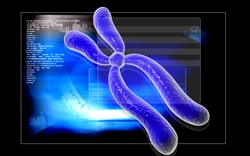Fighting cancer at the chromosome level
However, they also make cell division possible and may hold secrets about other cell division related phenomena such as how we age and whether or not cancer grows. In fact, shortened telomeres have been linked to a number of different types of cancer. Guanine (G)-rich nucleic acid sequences have the tendency to form four-stranded structures called quadruplexes and the human telomeric repeat sequence is one of these. Substances that bind (ligands) to telomeres and stabilise them are of particular interest in cancer therapy. Numerous ligands bind to the G-quadruplex but, until now, most of them were characterised by their flat structure, enabling them to stack on top of it. European researchers discovered by chance that helically-folded molecules called foldamers could bind to the human telomeric G-quadruplex and set up the ‘Foldamers: a new family of G-quadruplex ligands’ (FAR-QUAD) project to investigate and characterise the mechanism. The researchers synthesised 12 different foldamers and demonstrated specificity for stabilising the quadruplex structure as compared to the duplex structure. In addition, they carried out structure activity studies and identified the structural features required of a good quadruplex ligand. They then studied stabilising capability of the foldamers specifically with respect to DNA quadruplexes and found that foldamer 8 was the best ligand. Further studies confirmed the selectivity of foldamer 8 for nucleic acid sequences with a G-quadruplex structure, without sequence specificity (general binding to G-rich oligonucleotides), pointing the way to future continuation of this research, namely using foldamer 8 as a probe for other G-quadruplex structures in the entire genome. X-ray diffraction studies should enable the researchers to see the details of the interaction between ligand and binding site, enabling design of sequence-specific foldamers in the future. The results of the FAR-QUAD project have important implications in cancer therapy targeted at the telomeric end of chromosomes that has been implicated in numerous forms of cancer.







